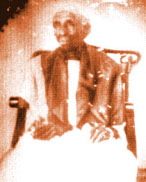

 The third stanza of an Aztec poem seeking help from Montezuma reads: A sweet-voiced flower is my mind, a sweet-voiced flower is my drum, and I sing the words of this flowery book. The entire poem, "A Song of the Huezoztincos"1 is an address in preparation for tribal war between the Huezoztincos, allies of the Aztecs, and the Tlascallans. The editorial interpretation of the "flowery book" is a literal one. Yet, when I read these lines A sweet-voiced flower is my mind, a sweet-voiced flower is my drum, I couldn't help but view them as echoing back to an earlier time in which the drum/mind relationship was literal, nonviolent, and in form with chanting as the earliest poetic expression. This would lend a further interpretation of the "flowery book" as signifying not just the presumed literal book but also the representational "book" as metaphor for the mind/drum flow presented through the "body" of the "book" which is self. This sweet-voiced open-petal-ed mind/drum line seems to recall an expression of one's self as rhythmic formation come into being, being that is represented rhythmically.
The third stanza of an Aztec poem seeking help from Montezuma reads: A sweet-voiced flower is my mind, a sweet-voiced flower is my drum, and I sing the words of this flowery book. The entire poem, "A Song of the Huezoztincos"1 is an address in preparation for tribal war between the Huezoztincos, allies of the Aztecs, and the Tlascallans. The editorial interpretation of the "flowery book" is a literal one. Yet, when I read these lines A sweet-voiced flower is my mind, a sweet-voiced flower is my drum, I couldn't help but view them as echoing back to an earlier time in which the drum/mind relationship was literal, nonviolent, and in form with chanting as the earliest poetic expression. This would lend a further interpretation of the "flowery book" as signifying not just the presumed literal book but also the representational "book" as metaphor for the mind/drum flow presented through the "body" of the "book" which is self. This sweet-voiced open-petal-ed mind/drum line seems to recall an expression of one's self as rhythmic formation come into being, being that is represented rhythmically.
*
In this poem the relationship between being, thinking and drumming presents itself and here also once again, with poetic relation. However, a significant shift has occurred for in this particular instance there is a warring, male-oriented aspect added to that relationship, but it wasn't always so.
From a time much earlier than that in which supplicants called for military aid from Montezuma, from many earlier times, including those in which frescoes were created as part of the birthing chapel in Hathor's Temple at Dendera, Egypt, to the paintings, reliefs and sculptures of Çatul Hüyük (Turkey, 5,800 BCE), there is evidence of drumming women whose relationship to and religious roles within their societies are traceable to concepts and practices involving peaceful, earth-centered ritual going all the way back to Paleolithic times in which a Great Mother Goddess was idolized and around whom ritual practices took shape that are interpreted as indicative of some level of human conscious-ness meditating on its relationship to the natural, earthly, seasonal, and motherly-imbued spiritual world.
*
The expression of ourselves as rhythmic formation come into being is revealed through our languages and our musically vocal sounds.
The expression of ourselves as rhythmic formation come into being and considered in harmony with and part of the natural world is seen in Paleolithic and Neolithic artifacts, cave paintings, murals, pottery and so forth, whose symbols and motifs are earth- and goddess-centered.
The expression of ourselves as rhythmic formation come into being and in harmony with the natural world is also found in rituals throughout the world whose practices involve drumming.
Note:
1 Anonymous, in The Sky Clears: Poetry of the American Indians, ed. A. Grove Day (A Bison Book: University of Nebraska Press, 1964), 177-178.
Image:
1. Ferminita Gómez, http://www.orishasplace.com/galeria.html






















